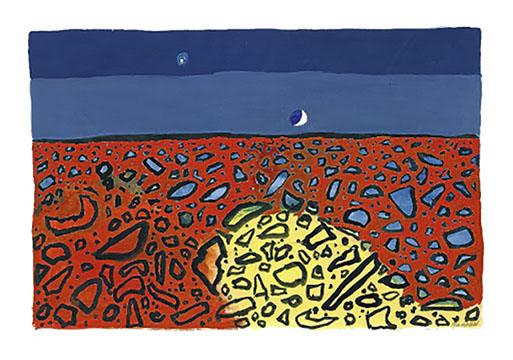
It is not often that the curator of an exhibition is keen to point out that no one has heard of the featured artist. Nevertheless, Christopher Till (1972) is a little excited that Brian Bradshaw is practically unknown because it has meant his oeuvre is not spread across homes around the world, and he has the privilege of undoing its obscure status.
He plans to do this with a large retrospective at the keenly awaited Javett Art Centre in Pretoria, which opens in 2019. In the meantime, he has curated a teaser of sorts, a gentle prelude, presenting the art of the UK-born artist in the form of a small exhibition of gouache works at the Ava Gallery in Cape Town.
Gouache is a flat medium seldom used by fine artists. However, in Bradshaw’s hands, he uses it to create bold, bright abstract works that appear contemporary despite being made in the 1970s. As Till so aptly puts it, Bradshaw "energises skies, clouds".
In Desert Moon, for example, Bradshaw divides an evening landscape into three bars of colour — the earth is described via a bold orange with black shapes carved into it, alluding to rocks, stones.
The horizon is a recurring motif in the landscape works, suggesting an unwavering pursuit of the essence of existence. This appears to have neatly dovetailed with his preoccupation with form.
"He looked for the rhythms and the motion in the landscape, the architectural elements," Till says reflectively.
Bradshaw had an interest in landscape painting while in his native England, but the colours he used are naturally subdued. There is less energy in the painting and composition.
It was the South African landscape, in particular the Eastern Cape, that he encountered when he moved to SA in 1960 to take up a post at the Rhodes University fine art department, that stirred his artistic language, manifesting in unusual abstract forms.
Before arriving in this country, the Lancashire-born artist had largely pursued a 1950s movement dubbed "kitchen-sink realism", according to Till.
It was quickly torpedoed by abstract expressionism, leaving the likes of Bradshaw at an awkward artistic juncture.
A move to a small Eastern Cape town, where the horizon and natural landscape would be in constant view, provided him with subject matter, allowing for an interplay between realism and abstraction.
He translates Eastern Cape vegetation such as acacia trees and euphorbias, into strange and unexpected shapes.
"This isn’t easy to do. I know, I have tried it," says Till. Having held positions as director of the Johannesburg Biennale, the Johannesburg Art Gallery and the Apartheid Museum, and as curator of the South African Pavilion at the Venice Biennale in 2015, Till is known for his curating abilities.
However, Bradshaw’s art appeals to Till as an artist who has grappled with translating SA’s landscape in novel ways. Having studied fine art at Rhodes under Bradshaw, Till observed the artist from his early years in SA, though Bradshaw had little time to make art until he retired from that position.
At his height at Rhodes he initiated and led the "Grahamstown group", a circle of artists who were united by their commitment to classical art training.
"He really engendered a belief that you had to be able to learn to draw properly. When Neville Dubow was making grass figures and putting them out to False Bay, he said that kind of art ‘was [rubbish]’."
As this recollection implies, Bradshaw was outspoken and slightly brusque.
"He was difficult, he would give the finger to the rest of the art establishment."
This may partially account for his seeming obscurity, though he enjoyed a high profile at an important art school. Grahamstown was not (and is not) an art centre and Bradshaw didn’t court attention in the bigger cities.
"He wasn’t interested in going to Joburg and promoting himself, he did not give a damn," recalls Till.
It didn’t help that he was English and his art didn’t contain links to the political and social issues that preoccupied most of the high-profile artists. This was particularly pertinent, given his interest in landscape painting— the genre is politically charged for locals.
"I don’t think he looked beyond the spiritual physicality of the landscape. He was interested in the volcanic moment of the creation rather than the human steps one sees. Force, creation, energy mass and how it rises up and joins with the sky is what interested him," Till says.
Charismatic, opinionated and defiant, Bradshaw was hard to forget.
Till thought of him often and on a tip from a friend visited him towards the end of his life in Heidelberg, where he had settled after leaving Grahamstown. Here Till discovered and was astonished by the quality and breadth of his work. When Bradshaw returned to the UK, Till packed up Bradshaw’s studio, gathering all his writings, diaries, etchings, early and late paintings with a view to staging a proper retrospective.
"I know his work. He has a particular way of representing the South African landscape that is largely unacknowledged. In the retrospective I will piece it together and reveal what a powerful painter he was."
The gouache works at the AVA Gallery form an introduction to the retrospective. If he was able to create this kind of visual drama through this flat medium, what might he have done with oils?
But, of course, the larger question is whether his art will finally find an audience. His legacy is probably in safe hands given Till’s clout as a curator and director. Till embodies his legacy too; he evinces an unwavering admiration for his former lecturer, who instilled something in him that has never been extinguished.
Brian Bradshaw shows at the AVA Gallery in Cape Town until the end of February. For more information about Bradshaw visit: Brianbradshawfoundation.org
20 February 2018 - 05:30
